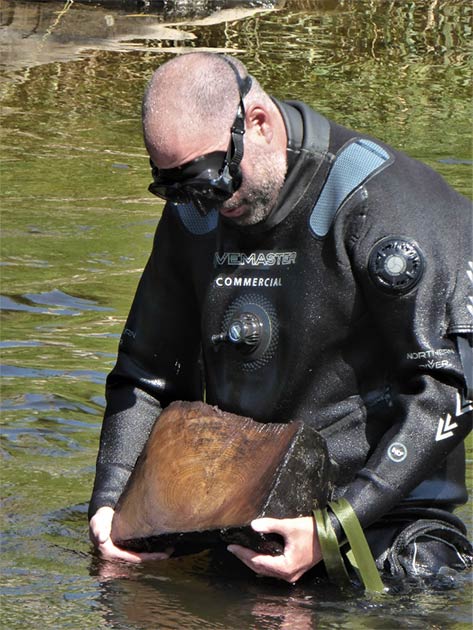A lost medieval bridge, dating back to the 1300s, has been discovered submerged beneath the whiskey-tinted waters of Scotland’s River Teviot. The cities, towns and villages of Middle Age Europe were built around harbors, rivers and canals. If you look at a map of Britain and Ireland, notice the number of major population centers built around the estuaries of rivers. Like in ancient Rome, Britain was knitted together by a mesh of waterways. While ancient Scots didn’t build kilometers of aqueducts, they were master bridge builders, and this newly discovered “lost” medieval bridge in Scotland proves it!
For the last two years, Historic Environment Scotland ( HES) has funded The Ancrum Old Bridge Project, which encompasses the work of a multi-disciplined community of Scottish history lovers. While some have been peeling through the dank pages of medieval texts, others have been wading through rivers, diving and surveying the area with drones, while a dedicated team of dendrochronologists has been painstakingly counting the rings on ancient timbers . Working in partnership with Dendrochronicle and Wessex Archaeology , this dynamic team of researchers together conducted the investigation on the River Teviot which led to the discovery of the lost medieval bridge.

Judith Coulson, a member of the Ancrum and District Heritage Society, found an extract from the local council minutes which sparked the hunt to discover the medieval bridge. The team then came across Blaeus Map of Teviotdale in 1654 which showed bridge 130 years before other known bridges had been constructed. ( ADHS)
Bridges Are Natural Targets for Ecological Destruction
You’d think ancient stone bridges would be permanent features on Scotland’s historic landscapes, but you’d be wrong. Scotland is prone to several months of freezing conditions every year. According to Scotland’s Oldest Bridges , every hundred years or so, freezing and thawing ice causes “old masonry bridges to deteriorate to the level of collapse” and floodwaters finalize the cycle of destruction. This means that no remaining Roman bridges can be found in Scotland and archaeological remains from the medieval age are scanty, to say the least.
What’s more, because bridges are generally located at the most practical places to cross rivers, the most significant old masonry bridges have all been completely replaced with modern steel designs. However, in the face of all this, the team of Ancrum and District Heritage Society ( ADHS) researchers first discovered cutwater platforms and native-oak timbers for supporting the “multi-arched bridge.” The ADHS researchers say these are seldom found at Scottish sites after around 1450 AD when timbers began being imported more frequently.
The shock and awe moment, however, came when the radiocarbon dating of timbers from the River Taviot bridge determined it was constructed in the mid-1300s, and stood for over four centuries. According to HES, this means that the medieval bridge is “the oldest bridge ever found in its original position across one of Scotland’s rivers.”

The “lost” medieval bridge was discovered by a multi-disciplined community of Scottish history lovers, seen here wading in the River Teviot. Thanks to their dedication, the Ancrum Old Bridge dating back to the 1300s was discovered in the Scottish borders. ( ADHS)
History Is All About Perspective
You and I both know that “history” is all about the storyteller’s perspective. It’s perhaps no surprise that HES celebrates the discovery, describing the medieval bridge as being “of historic and strategic national importance.” But the historic “value” of the bridge, according to HES, is because it was constructed during the reign of King David II of Scotland to cross the River Teviot on the Via Regia (Kings Way), from Edinburgh to Jedburgh and on to the Border.
Furthermore, HES informs us that James V would have crossed here in 1526 AD, as would Mary Queen of Scots returning from her tour of the Borders in 1566 AD. The Marquis of Montrose also crossed the medieval bridge on his way to battle at Philiphaugh in 1645 AD. Returning to “perspectives,” it’s best you know that in between these one-off “royal dates,” the lost bridge served thousands of farmers and tradespeople weekly.

Bob Armstrong, from Wessex Archaeology Coastal and Marine Team, as he retrieves a sample of bridge timber from the river. The ADHS team warns that the remains of the medieval bridge are under threat. ( ADHS)
Important Social Spine: Ancrum Bridge as “People’s” Treasure
What I am driving at here, is that this discovery doesn’t need any royal pomp to be recognized as an exceptionally important Scottish cultural treasure. In fact, its significance is amplified ten-fold when we look at it from “the people’s” perspective. Geoff Parkhouse from ADHS explains that the 14 th century Ancrum Bridge “may have been the only place to cross the Teviot between Hawick and Berwick, making it one of the most important structures in medieval Scotland.” This would make the medieval bridge an immensely important social spine, a community artery so to speak, representing one of the most important structures in non-regal medieval Scotland.
As if the rarity and early date of this bridge were not enough, the archaeologists say the bridge’s foundations were built using a system of branders: a strong wooden frame on the riverbed upon which the stones were assembled. So not only do we have the “oldest” bridge ever discovered in Scotland, but this is the first time a bridge-brander system has ever been found in situ in Scotland.
Top image: Ancrum and District Heritage Society (ADHS), a multi-disciplined community of Scottish history lovers, has discovered the remains of one of the oldest medieval bridge ever to have been discovered in Scotland. The bridge remains can be seen here in a drone image taken by Richard Strathie who conducted an aerial survey of the area. Source: ADHS
By Ashley Cowie
Views: 0
 RSS Feed
RSS Feed
















 October 30th, 2020
October 30th, 2020  Awake Goy
Awake Goy  Posted in
Posted in  Tags:
Tags: 
















